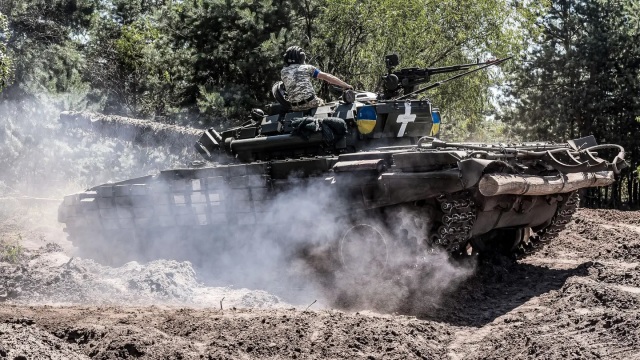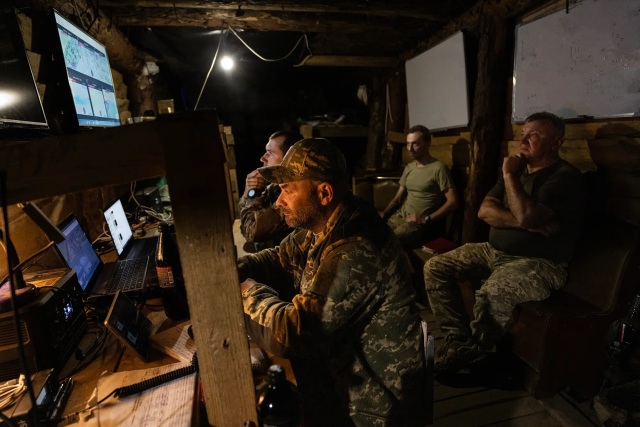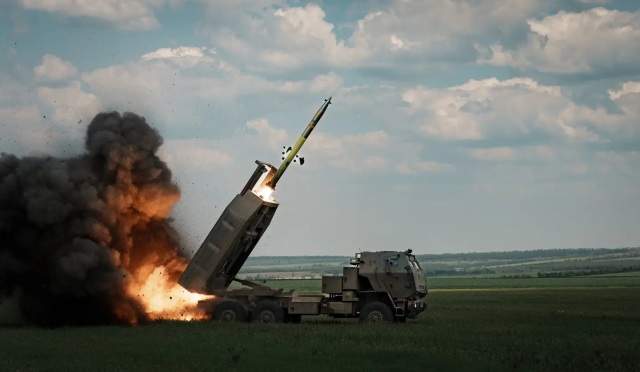The American web resource "The Drive" has published an interesting material by Howard Altman "A Sobering Analysis Of Ukraine's Counteroffensive From The Front" ("Sobering front-line analysis of the Ukrainian counteroffensive"), which outlines critical considerations about the offensive actions of the armed forces of Ukraine, expressed by a senior researcher at the British International Institute for Strategic Studies (International Institute for Strategic Studies - IISS) and the Center For New American Security (CNAS) by Franz-Stefan Gadi after his trip with a group of military analysts to the war zones in Ukraine.

T-72 tank from the 4th Separate Tank Brigade of the Armed Forces of Ukraine. Donetsk region, 18.07.2023 (c) Diego Herrera Carcedo / Anadolu Agency
A group of military analysts recently visited the frontline in Ukraine to get a closer look at the most brutal ground war in Europe in several generations. After spending time with Ukrainian troops who fought under massive volleys of Russian artillery, helicopter and tank attacks, drone strikes and in minefields, one of them returned with a sharp assessment of why the Ukrainian counteroffensive is moving slower than some expected.
A senior researcher at the Institute for International Strategic Studies and the Center for a New American Security, Franz-Stefan Gady, says that after his trip to Ukraine, it became clear to him that this country is struggling with how to use its forces. Once in combat, Ukrainian troops sometimes demonstrate poor tactics and lack of coordination between units. At the same time, they have to cope with the still deeply rooted bureaucracy, strife and constant reliance on "Soviet-style thinking." And then there are the Russians who "put up a tough resistance."
Conversely, there is no single reason - for example, the lack of more Western weapons, including long-range weapons systems and additional equipment for mine clearance - which would be the reason for the "lack of progress," the analyst says.
"The narrative that Ukraine's progress is still slow only because of the lack of arms supplies and support is one-sided and is not shared by those military with whom we spoke, and who are actually fighting and exercising command on the front line," Gadi said in an analytical post on Twitter, which he published on July 18 and a detailed description which is given later in this article.
Do not forget that the United States and its allies have already provided tens of billions of dollars worth of military aid to Ukraine with promises to continue supplies.
Meanwhile, Ukrainian officials have pointed, in particular, to minefields as a key factor in the pace of progress, but Ukrainians say they are slowly but steadily making progress.
Gadi visited Ukraine with a group that included Conrad Muzyka, an independent defense analyst specializing in Russia and Belarus and director of Rochan Consulting; Rob Lee, a senior fellow at the Institute for Foreign Policy Studies, and Michael Kofman, a senior fellow at the Carnegie Endowment and chief researcher at CNA.
It's one thing to study the conflict, Gadi said, but it's priceless to get into a war zone and talk to those who are fighting there.
"We formed an informal research group to get a better understanding of the war based on research on the ground," Gadi told The War Zone on July 19. "We just think it was important to go there to really feel what's going on and talk to people to get an idea of the situation, get an idea of the people involved in these battles on the Ukrainian side, see the terrain and so on."
This allows researchers to "always come back with lots of new ideas that you can't get from afar," Gadi said. - "We always come back with a lot of new data that we can use in our analysis to get a more accurate picture of the conflict. So we went to different parts of the front line."
According to him, during the visits they visited the Zaporozhye region and Donbass, although he refused to give more specific details.
Gadi shared the band's thoughts in a large 16-part Twitter post that is as insightful as it is concise.
Here are Gadi 's conclusions:
1.) By and large, there is an infantry battle (squad, platoon and company) with the support of artillery on most of the front line. This has several consequences.
First: Progress is measured in yards/meters, not kilometers/miles due to mobility limitations.
Secondly, Mechanized formations are rarely put into battle because of the lack of means to ensure their maneuver. This includes an insufficient number of mine clearance, air defense, ATGM, etc.
2.) The Ukrainian forces have not yet mastered combined arms operations on a large scale. Their operations are more consistent than synchronized. This creates various problems in the offensive, and, in my opinion, is the main reason for the slow progress.
3.) By default, the Ukrainian forces switched to a strategy of attrition, relying on consistent fire rather than maneuver. That's why cluster munitions are crucial to maintaining the current intensity of fire: it weakens Russian defenses to the extent that it allows maneuvering.
4.) As most observers know, minefields are a problem. They limit the room for maneuver and slow down the progress. But Ukraine's inability to conduct complex combined arms operations on a large scale has a much greater impact than the minefields themselves on Ukraine's ability to break through Russian defenses. The lack of a large-scale integrated combined arms approach makes Ukrainian forces more vulnerable to Russian ATGMS, artillery, etc. during the offensive. So it's not just about weapons. I just haven't observed any systematic destruction of the Russian defensive system.
Russian Russian defense is likely to change only if there is a more systematic approach to breaking through the Russian defense, possibly in combination with a serious degradation of the Russian morale, which may lead to a sudden or gradual collapse of the Russian defense. 5.) The nature of this offensive is likely to change only if there is a more systematic approach to breaking through the Russian defense, possibly in combination with a serious degradation of the Russian morale, which may lead to a sudden or gradual collapse of the Russian defense. I suspect that in the absence of a sudden collapse of the Russian defense, this will remain a bloody battle of attrition with the gradual deployment of reserve units in the coming weeks and months.
6.) There is limited evidence of systematic deep attacks [meaning missile strikes at a considerable range], which methodically destroy Russian C2 [command and control] / [ammunition depots]. Russian Russian rationing notwithstanding, ammunition is available to them, and the Russians seem to have a pretty good ISR [information, surveillance, reconnaissance] of the battlefield.
The Russians also had no need to deploy operational reserves to repel Ukrainian attacks. There is also evidence of a reduction in the impact of HIMARS strikes due to effective Russian countermeasures (this is important to keep in mind with regard to assessing any potential tactical impact of the delivery of ATACMS missiles).
Russian forces, even if they are severely weakened and lack ammunition, are likely capable of delaying or repelling attacks by Ukrainian platoon or company-level troops unless these attacks are better coordinated and synchronized on a wider front line.
7.) The quality of Russian troops is different. According to the Ukrainians we talked to, exhaustion has hit them hard, but they are defending their positions well. They were quite flexible at the tactical level and generally defended in accordance with the Soviet-Russian doctrine.
8.) Rationing of artillery [ammunition] in Russia is real and is happening in reality. Ukraine retains fire superiority in barrel artillery, while Russia retains superiority in MLRS in the south. However, only one local fire superiority in some calibers is not enough to break through the Russian defense.
9.) The additional influx of weapons systems (for example, ATACMS, air defense systems, tanks, infantry fighting vehicles, etc.), although important for maintaining military operations, most likely will not have a decisive tactical impact without adaptation and more effective integration.
Ukraine will have to better synchronize and adapt the current tactics, without which Western weapons will not be tactically decisive in the long run. This is happening, but the work is slow (most NATO-style military would have even more problems with this than Ukrainians, in my opinion).
10.) The above is also true for actions to overcome mines and obstacles. Additional mine clearance equipment is needed, and it will be useful (especially portable mine clearance systems), but it is not crucial without better integration of fire and maneuver at scale.
Again, I cannot stress enough how difficult it is to implement this in wartime.
One-sided explanations of failures (for example, lack of equipment for mine clearance) do not reflect reality. Russian Russian ATGMs, for example, stopped some Ukrainian attacks even before they entered the first Russian minefield.
11.) There is a shortage of artillery barrels [to replace them] [in the Armed Forces of Ukraine], which is difficult to solve, given the pace of their production and delivery time.
12.) So far, Ukraine's approach in this counteroffensive has consisted primarily of direct attacks on Russian positions, supported by rudimentary deep strikes. And no, these direct attacks are not just reconnaissance attacks.
13.) There is evidence of tactical cyber operations that support the closure of kinetic chains of destruction. This is cyber intelligence that helps to identify and track targets on the battlefield. Starlink remains an absolutely key tool for Ukrainian management and control.
14.) The quality of the Ukrainian officers and non-commissioned officers we met seems excellent, and morale remains high. Nevertheless, there are some problems with the quality of troops that arise in connection with the conscription of less able-bodied and elderly men.
15.) The narrative that Ukraine's progress is still slow only because of the lack of arms supplies and support is one-sided and is not shared by those military with whom we spoke, and who are actually fighting and exercising command on the front line.
16.) It goes without saying that in a war of attrition, more artillery ammunition and weapons are always needed, and they must be constantly supplied. Western support for Ukraine, of course, must continue, since there is still the prospect that the counteroffensive will bring success. But the soldiers fighting on the front line, with whom we talked, know all too well that the lack of progress is most often due to the specific use of forces, poor tactics, lack of coordination between units, bureaucratic red tape/strife, Soviet-style thinking, etc ... - and with the Russians offering tough resistance.
We asked Gadi to go a little deeper into a couple of comments he made.
On July 18, the chairman of the Joint Chiefs of Staff of the US Armed Forces, General Mark Milley, told reporters that the US and its allies had trained 17 brigade combat teams - 63,000 Ukrainian servicemen - in combined arms combat operations. Other brigades are in the training stage.
But Ukraine is having problems on the battlefield with carrying out these coordinated large-scale maneuvers due to the tight training deadlines when it faces "one of the most powerful armies in the world," Gadi told us.
Ukraine "probably conducts a lot of combined-arms actions at the level of small units, but I think it needs to scale up," he said.
The US "probably expects some results with all the aid and military equipment they have provided," Gadi said. - "The main idea here was to train mechanized brigades equipped with Western weapons in combined-arms maneuvers. I think this approach has had some setbacks. I'm not sure if it has failed across the board. I think it just requires a more concerted effort."
However, Gadi hastened to emphasize that "no Western armed forces can conduct this kind of combined arms operations on a large scale, with the exception of the United States. But even the armed forces of the United States will find it very difficult to break through these defensive layers, because no Western army in the world currently has experience breaking through such a deeply-layered defense that the Russians have built in the south and east of Ukraine."
For a long time, since they first arrived on the battlefield in Ukraine, the M142 HIMARS high-altitude missile systems have acquired an almost mythical status for Ukraine. The GMLRS guided missiles they fired had a longer range (about 50 miles) than the available Ukrainian MLRS or barrel artillery, and had a devastating impact, especially on Russian logistics hubs.
But Russia has found ways to counter GMLRS, Gadi said when asked to explain in more detail what he said in his post.
"Russian electronic warfare appears to be influencing the successful application of GMLRS," he told us. - "Russian echeloned integrated air and missile defense seems to have had an impact too, and it also managed to shoot down some of these GMLRS."
As a result, "I think it's fair to say that the HIMARS effect from last summer is definitely over," Gady said. "Therefore, I think we should keep this in mind when we think about other high-precision long-range munitions that have been provided to Ukraine. Russia will sooner or later find a counteraction to them."
The views expressed by Gadi and his colleagues give a much more sober idea of the Ukrainian counteroffensive than what follows from the official statements of Kiev and the Pentagon.
When asked to summarize his assessment, Gadi told us the following.
"This is a stubborn battle characterized by high rates of attrition, and the Ukrainian forces are gradually getting results," he said. - "The potential for Ukrainian military success still exists."
Gadi said that he and his colleagues will provide additional information about their trip to Ukraine in the future.

Command post of the 3rd separate assault Brigade of the Armed Forces of Ukraine in the area of Bakhmut, 16.07.2023 (c) Paula Bronstein

The combat vehicle of the American M142 HIMARS missile system fires GMLRS guided missiles at Russian positions in the Bakhmut area, 2023 (c) Serhii Mykhalchuk
